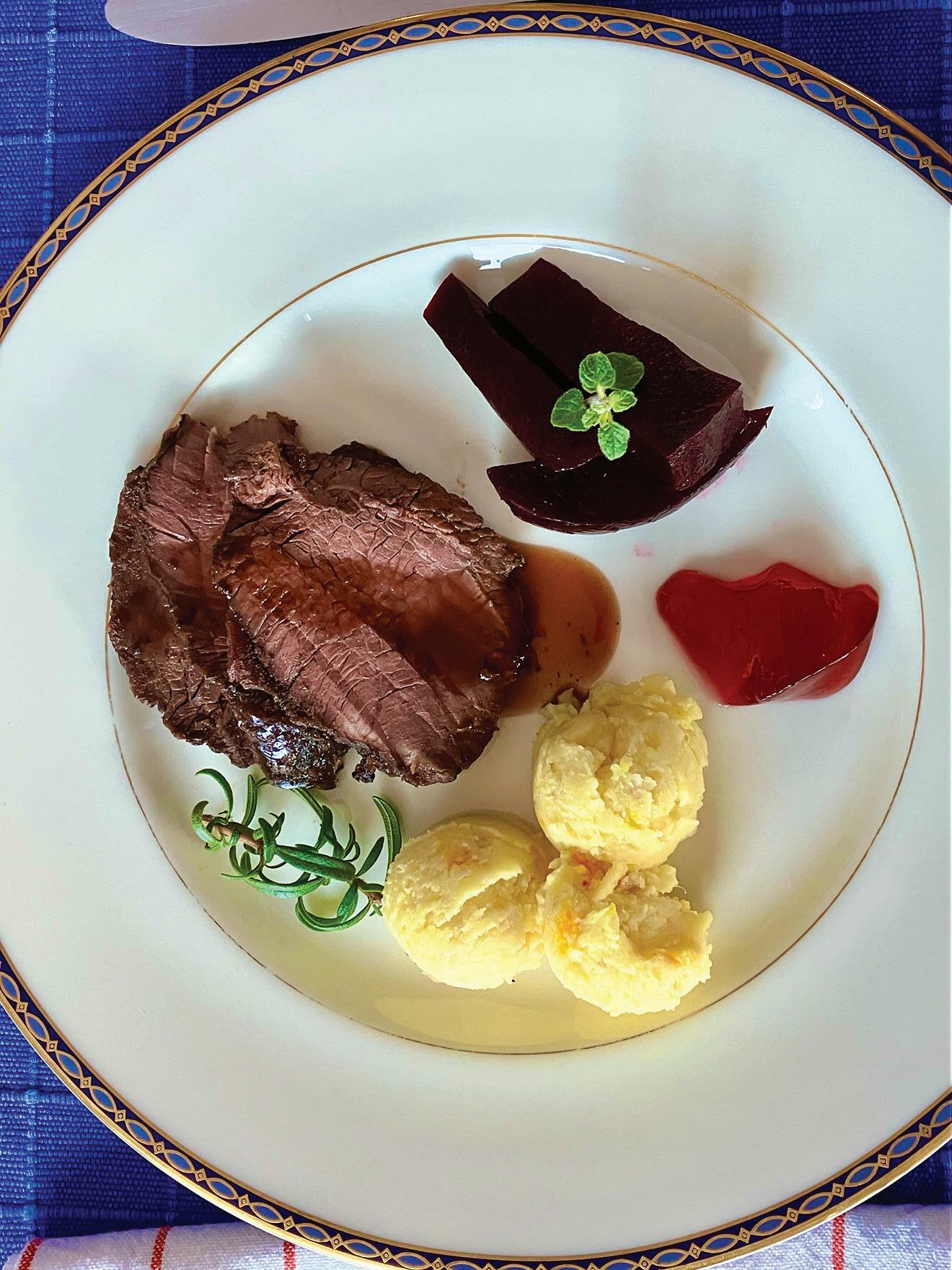
5 minute read
Gather
Michele Genest is a Whitehorse-based chef and writer. She is also somewhat of a gardener. Michele has also written two books—The Boreal Feast: A Culinary Journey Through The North, and The Boreal Gourmet: Adventures In Northern Cooking.
HOW TO COOK A MOOSE
Iwant to share with you a success I had this weekend. But fi rst, hands up anyone who has ever overcooked a moose roast. Yes, that is my hand you see, waving sheepishly. After all the work and care that has gone into hunting, harvesting, fi eld dressing, hauling to camp, bringing home and butchering this magnifi cent animal, it really sucks to mess up the cooking part.
The secret to success is hiding in plain sight: an instant-read thermometer. I know, you’ve seen them advertised in fl yers and in your social media feed, but you’ve always thought, Nah, I know how to cook a moose. I can tell when it’s done by the colour of the juices when I pierce it with a knife, or how it feels when I press it with my fi nger.
That works for you consistently, every time, right? Right.
So, I had a one-and-a-half-pound piece of moose meat that my generous hunter friend gave me, a fi ne-grained piece of rump meat she had labelled “primo roast.” It’s a big deal to get such a nice piece of meat, and I saved it up for an event. There were people coming for dinner, a private party of four, celebrating a special occasion, who had asked me to cook for them.
I couldn’t afford to screw up. I had my thermometer at the ready.
Here’s what I did: I rubbed the meat in the morning with a combination of ground espresso, herbs, spices, salt and brown sugar. After letting it sit in the fridge all day, I seared it on each side, in butter and oil, in a castiron frying pan. While the guests were on the appetizer course, I put the roast in the oven, in the frying pan, with a timer set for 40 minutes at 350°. (I took a calculated risk here—my fi rst thought was to cook it at a higher temperature, but the potato souffl é needed to cook at 350°, and everything had to be ready at around the same time.)
I watched the time closely and at 35 minutes tested the temperature of the meat with the instant-read thermometer. It was 135°, the sweet spot between rare and medium rare. I whipped it out of the oven, tented foil over top and let it sit for 15 minutes while the guests ate their salads and the souffl é continued cooking. (This resting period is important: if you cut into the meat right away, the juices leave the meat like a crowd pouring out of a soccer stadium.)
When I sliced into the meat, it was a perfect medium rare, tender and juicy. Whew: what an absolute and major Whew! I hadn’t let the roast, the hunter or my guests down.
Here’s the thing about an instant-read thermometer: it takes away the guesswork. A good one costs about $43 from Lee Valley (But, what price peace of mind?). Don’t worry, this story will not be followed by a reveal that I’m working for the company. I just want you to eat better moose.
The fi nal touches on the primo roast were two accompanying sauces: morel mushroom cream sauce and a port, beef stock and berry reduction. The reduction recipe is included here because, to my mind, it’s the best-possible gravy.
And that is the story of my moose success.
Perfect Medium Rare Moose Roast
Scale up the rub ingredients, according to the size of your roast, and use a good cut. (PS: Test the temperature sooner than you think you should.)
Ingredients
❑ One 1.5 lb moose roast ❑ 1 Tbsp ground espresso coffee ❑ 1 Tbsp brown sugar ❑ 1 tsp kosher salt ❑ 1 Tbsp chopped fresh rosemary, or 1 tsp dried ❑ 2 tsp coriander seed, coarsely ground ❑ 1/2 tsp cayenne pepper ❑ 1 Tbsp olive oil ❑ 1 Tbsp butter
Instructions
• Whisk together coffee and spices and pour onto a dinner plate, spreading the mix around. • Roll the roast in the rub, pressing it in, covering the whole roast evenly. Place in a resealable bag and let sit for 6 to 8 hours. • Preheat oven to 350°. Heat butter and oil in a cast-iron frying pan over medium heat. Allow the fat to get as hot as possible, without letting the butter brown (you want the meat to sizzle as soon as it hits the pan). • Cook each side for 1 or 2 minutes, until a deep brown. Remove from burner and place in the oven. Roast until an instant-read thermometer registers the temperature at 135°, from 35 to 40 minutes. Remove from oven and allow to rest under a tinfoil tent, for at least 15 minutes. • Slice thinly, against the grain, and serve with a drizzle of reduction sauce over top. Put a small pitcher of reduction on the table, along with a morel mushroom cream sauce. Makes 4 to 6 servings.
Perfect Medium Rare Moose Roast
PHOTO: Michele Genest
Reduction Sauce
Typically, a reduction sauce is made from juices in the pan, along with additions like wine, berries, stock, cream or butter. Because I knew the remainder of the coffee rub left in the pan would be quite a pronounced fl avour, I opted to make the reduction sauce separately.
Ingredients
❑ 3 cups strong beef, moose or bison stock ❑ 1/3 cup port wine ❑ 2 Tbsp highbush cranberry jelly (substitute any berry jelly of your choosing) ❑ 2 Tbsp cold butter
Instructions
• Whisk together ingredients in a small pot. Set pot on a burner at medium-high and boil until the sauce is thick and syrupy and reduced to about half a cup. This will take 30 or 40 minutes. When the volume is at one cup it reduces quickly, so keep a close eye on the pot and taste-test, with a tester spoon, frequently. • Remove sauce from heat and beat in cold butter one tablespoon at a time.
Reheat sauce at a low temperature so the butter doesn’t “break” and the fat separates. Makes about 1/2 cup. n
(Formerly Tony’s Pizzeria - We’re Back!)

ORDER (867) 336-7492
pizzaheavenwhitehorse@gmail.com






